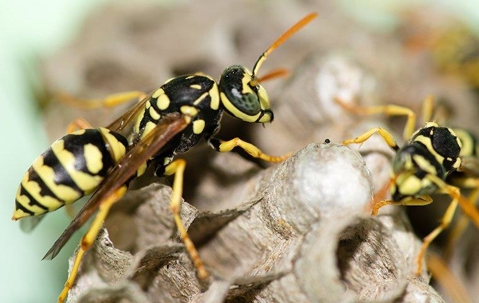You’re minding your own business, enjoying time outdoors on your property. Maybe you’re sipping a cold beverage or having a bite to eat when suddenly, you hear that dreaded buzzing floating around your head. If wasps were just annoying, intrusive pests, that would be one thing. But these nasty bugs pack a painful sting that can make spending time outside difficult.
Fortunately, there’s a method to defending against wasps. And if you want to get control of your property, you ought to know the secret about how to keep wasps away in Plano.
About Wasps In Plano
Several types of wasps call Plano home. While many folks think of wasps as living in large, elaborate nests like their cousins the bees, wasps can either live in groups or by themselves, depending on the species. Both solitary and social wasps cause trouble for property owners in Plano.
- Mud daubers: These solitary wasps can measure between 1 1/2 to 2 inches in length. They are known for their distinct elongated waist that resembles a thin piece of wire connecting their body segments. Species of mud dauber wasps vary in color from black to metallic blue.
- Yellowjackets: Common throughout the continental U.S., yellowjackets are social wasps that are known to build large underground nests. These wasps have a black and yellow striped pattern and usually measure about 1/2 inch in length.
- Paper wasps: Like mud daubers, paper wasps aren’t any one species but are several species of wasps with similar traits and behaviors. Paper wasps build papier mache-like nests that resemble upside-down umbrellas in terms of shape. They can be brown or yellowish in color and measure between 5/8 to 3/4 of an inch in size.
What Attracts Wasps To My Property?
If you’ve got wasps on your property, it’s likely because you’ve got lots of food for wasps to eat. Wasps are predators that feed on smaller insects like spiders and flies, but are also known to scavenge scraps of meat from cookouts and outdoor parties. If you have a large population of prey insects in your yard or if you’ve got open garbage cans or trash bags that wasps can raid, you may be drawing them to your property.
Besides meat, wasps are also known to have a bit of a sweet tooth. As the summer season ends, many wasps turn to sugary nectar to fill their bellies. Wasps are attracted to many sweet-smelling flowering plants and fruit-bearing trees. Sweet fennel, Queen Anne’s lace, and yarrow are all plants that attract wasps.
How To Prevent Wasps In Plano
There are several effective ways to prevent or reduce the population of wasps on your property.
- Eliminate nesting sites: You can prevent wasps from establishing nests by repairing damage to the siding of your home or business. Filling in holes in the ground with gravel or soil can discourage wasps from residing on your property.
- Repel wasps with plants: Wasps hate certain plants like marigolds, lemongrass, and basil. It’s also believed that wasps are repelled by red-colored flowers. Planting these can help keep wasps off your property.
- Get rid of prey insects: Simply doing regular yard work can reduce the presence of wasps by getting rid of the prey they feed on. Overgrown grass, hedges, and organic waste can attract bugs that wasps feed on. Eliminate hiding spots for prey insects by keeping a tidy yard.
If you’ve got a wasp problem on your Plano property, don’t try to tackle it on your own. Contact the experts at Adams Exterminating for safe and effective control of wasps and other stinging insects. For four generations, our family has been serving North Texas with exceptional customer service and powerful pest control. Get in touch with us today for your free inspection.

